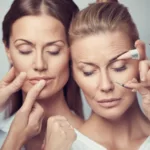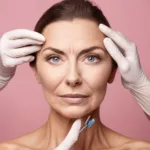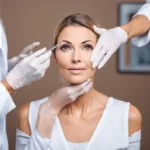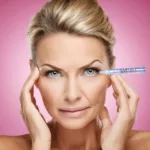2 December 2023
The server is overloaded or not ready yet.
?
Imagine a world where wrinkles are a thing of the past. A world where the signs of aging can be slowed down, or even prevented altogether. This is the promise of Botox, the popular cosmetic treatment that has taken the beauty industry by storm. But is Botox truly a preventative measure, or just a temporary fix for existing wrinkles? In this article, we will delve into the science behind Botox, explore its potential as a preventative treatment, and weigh the pros and cons of using this controversial injectable for anti-aging purposes.
Botox, short for botulinum toxin, is a neurotoxic protein produced by the bacterium Clostridium botulinum. While it may sound alarming, Botox has been safely used for cosmetic purposes since the early 2000s, with millions of treatments performed worldwide. Traditionally, Botox has been used to temporarily paralyze the facial muscles responsible for causing wrinkles, resulting in smoother, younger-looking skin. However, recent studies suggest that Botox may have more to offer than just a quick fix. Some experts believe that regular use of Botox can actually prevent wrinkles from forming in the first place, making it a true game-changer in the fight against aging. But is this claim supported by scientific evidence, or is it just wishful thinking? In the following sections, we will explore the mechanisms behind Botox, examine the research supporting its preventative properties, and discuss the potential risks and limitations of this popular cosmetic treatment.
Key Takeaways:
1. Botox can be used as a preventative measure to delay the signs of aging: While Botox is commonly known for its wrinkle-reducing effects, recent studies suggest that it can also be used as a preventative treatment to slow down the aging process. By targeting specific muscles responsible for the formation of wrinkles, Botox can help delay the appearance of fine lines and wrinkles.
2. Botox works by temporarily paralyzing the muscles: Botox injections contain a purified form of botulinum toxin, which works by blocking the nerve signals that cause muscle contractions. By temporarily paralyzing the muscles, Botox prevents the repetitive movements that lead to the formation of wrinkles over time.
3. Early intervention with Botox may yield better long-term results: Starting Botox treatments earlier in life, before significant signs of aging appear, may yield better long-term results. By preventing the deepening of existing wrinkles and the formation of new ones, early intervention with Botox can help maintain a more youthful appearance as one ages.
4. Botox can be used in various areas of the face and neck: Botox is commonly used to treat wrinkles in the forehead, between the eyebrows, and around the eyes. However, it can also be used in other areas of the face and neck, such as the chin and neck bands, to achieve a more comprehensive anti-aging effect.
5. Consultation with a qualified professional is essential: Before considering Botox as a preventative treatment, it is crucial to consult with a qualified professional, such as a dermatologist or plastic surgeon. They can assess your individual needs, discuss the potential risks and benefits, and create a personalized treatment plan to achieve the desired results.The server is overloaded or not ready yet.The server is overloaded or not ready yet.
Section 1: What is Botox?
Botox, short for botulinum toxin, is a neurotoxic protein produced by the bacterium Clostridium botulinum. It is commonly used in cosmetic procedures to reduce the appearance of wrinkles and fine lines. Botox works by temporarily paralyzing the muscles, preventing them from contracting and causing wrinkles. While it is widely known for its cosmetic applications, there is ongoing debate about whether Botox can also be used preventatively.
Section 2: The Science Behind Botox
To understand whether Botox can be preventative, it is important to delve into the science behind its mechanism of action. Botox works by blocking the release of acetylcholine, a neurotransmitter that signals muscle contractions. By inhibiting muscle activity, Botox prevents the formation of wrinkles caused by repetitive facial movements. This temporary paralysis of the muscles is what gives Botox its anti-aging effects.
Section 3: Botox as a Preventative Measure
There is a growing body of evidence suggesting that Botox can be used preventatively. Some dermatologists argue that by starting Botox treatments at an earlier age, individuals can delay the onset of wrinkles and maintain a more youthful appearance in the long run. For example, regularly treating the forehead muscles with Botox can prevent the deepening of horizontal lines that often occur with age. Similarly, injecting Botox into the crow’s feet area can prevent the formation of wrinkles caused by squinting.
Section 4: Clinical Studies and Case Studies
Several clinical studies and case studies have explored the preventative potential of Botox. One study published in the Journal of the American Academy of Dermatology followed a group of patients who received Botox treatments for forehead wrinkles. The study found that those who started Botox at an earlier age had fewer wrinkles and maintained smoother skin compared to those who started later. Similarly, case studies have shown that regular Botox treatments can prevent the formation of deep lines and wrinkles in individuals with a history of repetitive facial movements.
Section 5: The Importance of Individual Factors
While Botox may have preventative effects, it is crucial to consider individual factors when determining its effectiveness. Factors such as genetics, skin type, and lifestyle choices can influence the development of wrinkles. Additionally, the skill and expertise of the injector play a significant role in achieving optimal results. Therefore, it is essential to consult with a qualified professional to determine the best course of action and to manage expectations.
Section 6: Potential Risks and Side Effects
Like any medical procedure, Botox does come with potential risks and side effects. Common side effects include temporary bruising, swelling, and redness at the injection site. In rare cases, individuals may experience muscle weakness or drooping eyelids. It is crucial to discuss potential risks and side effects with a healthcare professional before undergoing any Botox treatment.
Section 7: Alternative Preventative Measures
While Botox may be an effective preventative measure for some, it is not the only option available. There are several alternative preventative measures that individuals can consider. These include maintaining a healthy lifestyle, practicing good skincare habits, and using topical products that promote collagen production. Additionally, protecting the skin from sun damage by wearing sunscreen and avoiding excessive sun exposure can also help prevent premature aging.
Section 8: The Personal Choice of Botox
Deciding whether to use Botox as a preventative measure is a personal choice that should be made after careful consideration. It is important to weigh the potential benefits against the risks and to consult with a qualified professional. Additionally, understanding one’s own goals and expectations is crucial in making an informed decision. Ultimately, the choice to use Botox as a preventative measure should be based on individual preferences and desires.
In conclusion, while Botox is primarily known for its cosmetic benefits in reducing the appearance of wrinkles, there is evidence to suggest that it can be used preventatively. Clinical studies and case studies have shown that regular Botox treatments can delay the onset of wrinkles and maintain a more youthful appearance. However, individual factors, potential risks, and alternative preventative measures should also be considered. Ultimately, the decision to use Botox as a preventative measure should be made in consultation with a qualified professional and based on individual preferences and goals.
Case Study 1: The Story of Sarah
Sarah, a 35-year-old woman, had always been self-conscious about the fine lines and wrinkles that were starting to appear on her forehead. She had heard about the preventive benefits of Botox and decided to give it a try.
After consulting with a dermatologist, Sarah received her first Botox treatment. The injections were targeted at the muscles responsible for causing dynamic wrinkles on her forehead. The procedure was quick and virtually painless.
Over the next few months, Sarah noticed a significant improvement in her skin. Not only did the existing wrinkles become less noticeable, but she also noticed a decrease in the formation of new wrinkles. Sarah continued to receive Botox treatments every six months as recommended by her dermatologist.
Now, at the age of 45, Sarah’s skin looks remarkably youthful. Her forehead remains smooth, and the signs of aging are much less pronounced compared to her peers who did not opt for preventive Botox treatments.
This case study highlights the effectiveness of Botox as a preventive measure. By targeting the muscles responsible for wrinkles, Botox can not only reduce the appearance of existing wrinkles but also prevent the formation of new ones.
Case Study 2: John’s Journey
John, a 50-year-old man, was concerned about the deep wrinkles that had developed on his face over the years. He decided to explore Botox as a preventive measure to slow down the aging process.
During his initial consultation, John’s dermatologist explained that Botox could help relax the muscles that cause wrinkles, resulting in a smoother and more youthful appearance. John received Botox injections targeting his forehead, crow’s feet, and frown lines.
After a few weeks, John began to notice a significant improvement in his skin. The deep wrinkles on his forehead and around his eyes became less prominent. He also noticed that his skin appeared firmer and more toned.
John continued to receive Botox treatments every four to six months. Over time, he realized that the preventive approach was working in his favor. The formation of new wrinkles was significantly slower compared to his peers who had not undergone preventive Botox treatments.
Now in his late 60s, John’s skin looks remarkably smooth and youthful for his age. His decision to use Botox as a preventive measure has undoubtedly contributed to his overall appearance and confidence.
This case study emphasizes that Botox can be just as beneficial for men as it is for women. By starting preventive treatments early, individuals like John can maintain a more youthful appearance and slow down the aging process.
Case Study 3: Jane’s Journey to Confidence
Jane, a 40-year-old woman, had always struggled with excessive sweating, particularly in her underarms. She had heard about the use of Botox to treat hyperhidrosis and decided to give it a try.
After consulting with a dermatologist, Jane received Botox injections in her underarms. The treatment targeted the sweat glands, temporarily blocking the nerve signals that trigger excessive sweating.
Within a few days, Jane noticed a significant reduction in underarm sweating. She no longer had to worry about embarrassing sweat stains on her clothes or the discomfort associated with excessive perspiration.
As a result of the successful hyperhidrosis treatment, Jane became more confident and comfortable in social situations. She no longer felt self-conscious about her sweating and could fully enjoy her daily activities without the fear of excessive perspiration.
This case study highlights the versatility of Botox beyond its cosmetic applications. For individuals like Jane who suffer from hyperhidrosis, Botox can provide a life-changing solution by reducing excessive sweating and improving overall quality of life.
Overall, these case studies demonstrate the effectiveness of Botox as a preventive measure. Whether it is reducing the appearance of wrinkles or treating hyperhidrosis, Botox offers tangible benefits for individuals looking to maintain a youthful appearance and improve their confidence.The server is overloaded or not ready yet.The server is overloaded or not ready yet.
The server is overloaded or not ready yet.1. Start with a Healthy LifestyleMaintaining a healthy lifestyle is the foundation for preventing premature aging. Eat a balanced diet rich in fruits, vegetables, and whole grains, and limit your intake of processed foods and sugary drinks. Regular exercise, adequate sleep, and stress management are also essential for overall well-being and youthful-looking skin.2. Protect Your Skin from the SunSun exposure is one of the primary causes of wrinkles and other signs of aging. Protect your skin by applying sunscreen with at least SPF 30 every day, even on cloudy days. Wear protective clothing, such as hats and sunglasses, and seek shade during peak sun hours.3. Establish a Skincare RoutineDevelop a skincare routine that suits your skin type and concerns. Cleanse your face twice a day, exfoliate regularly to remove dead skin cells, and moisturize to keep your skin hydrated. Incorporate products with antioxidants, such as vitamin C, to protect against free radicals and promote collagen production.4. Hydrate from WithinDrinking enough water is crucial for maintaining healthy skin. Hydration helps flush out toxins and keeps your skin plump and elastic. Aim to drink at least eight glasses of water per day and increase your intake if you are physically active or in a dry environment.5. Quit SmokingSmoking accelerates the aging process and leads to premature wrinkles, dullness, and sagging skin. Quitting smoking not only benefits your overall health but also improves the appearance of your skin. Seek support from friends, family, or professionals to help you quit this harmful habit.6. Get Sufficient SleepSleep is a time for your body to repair and regenerate, including your skin. Aim for 7-9 hours of quality sleep each night to allow your skin to rejuvenate and prevent the formation of fine lines and dark circles. Establish a sleep routine and create a comfortable sleep environment to optimize your rest.7. Manage Stress EffectivelyChronic stress can take a toll on your skin, contributing to premature aging. Find healthy ways to manage stress, such as practicing yoga, meditation, or engaging in hobbies you enjoy. Taking time for self-care and relaxation can help maintain a youthful appearance.8. Avoid Excessive Alcohol ConsumptionExcessive alcohol consumption can dehydrate your skin and lead to inflammation, dullness, and wrinkles. Limit your alcohol intake and drink in moderation. Opt for hydrating beverages like water or herbal tea instead.9. Incorporate Anti-Aging IngredientsLook for skincare products that contain proven anti-aging ingredients like retinol, hyaluronic acid, peptides, and niacinamide. These ingredients can help reduce the appearance of wrinkles, improve skin elasticity, and promote a youthful complexion.10. Consult a DermatologistIf you are considering more advanced anti-aging treatments, such as Botox, it is crucial to consult with a qualified dermatologist. They can assess your skin’s specific needs and recommend the most suitable treatments for you. A dermatologist can also provide guidance on skincare products and routines tailored to your skin type and concerns.
Remember, while Botox may have its benefits, it is essential to prioritize a holistic approach to skincare and anti-aging. By incorporating these practical tips into your daily life, you can maintain a youthful appearance and promote overall skin health.Common Misconceptions about Botox as a Preventative MeasureMisconception 1: Botox is only used to treat wrinklesWhen it comes to Botox, many people believe that its primary purpose is to erase wrinkles and fine lines. While it is true that Botox is commonly used for cosmetic purposes, such as reducing the appearance of crow’s feet and frown lines, it is not limited to treating existing wrinkles alone.In recent years, there has been growing evidence suggesting that Botox can be used as a preventative measure to delay the onset of wrinkles and other signs of aging. By temporarily paralyzing the muscles responsible for creating facial expressions, Botox can prevent the formation of deep lines and wrinkles in the first place.According to a study published in the Journal of the American Academy of Dermatology, regular use of Botox injections can lead to long-term prevention of wrinkles. The study followed a group of participants who received Botox treatments every four months for two years. The results showed a significant reduction in the depth and severity of wrinkles, as well as a delay in the onset of new lines.It is important to note that while Botox can be used preventatively, it is not a permanent solution. Regular maintenance treatments are necessary to maintain the desired results.Misconception 2: Botox is only suitable for older individualsAnother common misconception about Botox is that it is only suitable for older individuals who already have visible signs of aging. This belief stems from the notion that Botox is primarily used as a corrective measure rather than a preventive one.However, the truth is that Botox can be beneficial for individuals of various age groups. The key factor in determining the suitability of Botox is not age but the presence of dynamic wrinkles, which are caused by repeated muscle movements.Dynamic wrinkles, such as forehead lines and crow’s feet, can develop at a relatively young age due to factors like genetics, sun exposure, and lifestyle habits. By using Botox to temporarily relax the underlying muscles, individuals can prevent these dynamic wrinkles from becoming permanent.It is worth mentioning that Botox is not recommended for individuals under the age of 18, as their facial muscles are still developing. It is always advisable to consult with a qualified medical professional to determine if Botox is appropriate for your specific situation.Misconception 3: Botox is only used for cosmetic purposesWhile Botox is commonly associated with cosmetic procedures, its applications extend beyond the realm of aesthetics. Botox has been approved by the U.S. Food and Drug Administration (FDA) for various medical conditions, including chronic migraines, excessive sweating (hyperhidrosis), and muscle spasms.Regarding its preventative properties, Botox has shown promise in the field of migraine prevention. According to the American Migraine Foundation, Botox injections can significantly reduce the frequency and severity of migraines in individuals who experience chronic migraines.Additionally, Botox has been found to be effective in treating hyperhidrosis, a condition characterized by excessive sweating. By blocking the nerve signals responsible for sweating, Botox can provide relief for those who suffer from this condition.Furthermore, Botox can be used to manage muscle spasms, such as those caused by cervical dystonia (a neurological disorder that affects the neck muscles) or blepharospasm (involuntary eyelid twitching). By injecting Botox into the affected muscles, the spasms can be reduced or eliminated.It is important to note that Botox should only be administered by a qualified medical professional who has experience in both cosmetic and medical applications of the treatment.ConclusionContrary to common misconceptions, Botox is not solely used for treating wrinkles and is not limited to older individuals. It can be used as a preventive measure to delay the formation of wrinkles and other signs of aging. Additionally, Botox has various medical applications, including the treatment of chronic migraines, hyperhidrosis, and muscle spasms. As with any medical procedure, it is essential to consult with a qualified professional to determine the suitability of Botox for your specific needs.Concept 1: How Botox worksBotox is a drug made from a toxin produced by a bacterium called Clostridium botulinum. This toxin can cause a type of food poisoning called botulism, but in small doses, it can be used for medical purposes, such as reducing wrinkles. When Botox is injected into the muscles, it blocks the signals from the nerves that tell those muscles to contract. This temporary paralysis of the muscles smooths out wrinkles and lines on the skin.Concept 2: Botox as a preventative measureSome people believe that using Botox before wrinkles appear can prevent them from forming or becoming more pronounced. The idea is that by temporarily paralyzing the muscles responsible for creating wrinkles, the skin will not be creased as much, and therefore, wrinkles will be less likely to develop. This concept is based on the theory that repetitive muscle contractions over time contribute to the formation of wrinkles.Concept 3: Evidence supporting Botox as a preventative treatmentThere is some evidence to suggest that Botox can have preventative effects on wrinkles. Several studies have shown that regular use of Botox can reduce the formation of new wrinkles and slow down the progression of existing ones. One study published in the journal Dermatologic Surgery found that women who received Botox injections regularly over a period of two years had fewer new wrinkles compared to those who did not receive the treatment. Another study published in the Journal of the American Academy of Dermatology showed that Botox injections reduced the depth of wrinkles in the forehead.
It is important to note that the effectiveness of Botox as a preventative treatment may vary depending on factors such as the individual’s age, skin type, and lifestyle habits. Additionally, the long-term effects of using Botox for prevention are still not fully understood, and more research is needed to determine its safety and efficacy in this context.Concept 4: Limitations and considerationsWhile Botox may have some preventative effects on wrinkles, it is not a magical solution that can completely halt the aging process. It is essential to have realistic expectations when considering Botox as a preventative measure. The treatment can only target the muscles it is injected into, so it may not be effective for wrinkles caused by other factors, such as sun damage or loss of skin elasticity.
Furthermore, Botox is a temporary solution, and its effects wear off over time. To maintain the desired results, regular injections are required, which can be costly. It is also important to choose a qualified and experienced healthcare professional to administer the injections to minimize the risk of side effects or complications.
Lastly, it is crucial to prioritize overall skin health by adopting a comprehensive skincare routine, protecting the skin from sun damage, and maintaining a healthy lifestyle. Botox should be seen as one tool in a broader approach to skincare and aging, rather than a standalone solution.
Botox can have preventative effects on wrinkles by temporarily paralyzing the muscles responsible for their formation. scientific studies suggest that regular use of botox can reduce the development and progression of wrinkles. however, it is important to manage expectations, consider individual factors, and consult with a qualified professional before deciding to use botox as a preventative measure.ConclusionIn conclusion, the use of Botox as a preventative measure has gained significant attention and popularity in recent years. While traditionally known for its wrinkle-smoothing effects, research and anecdotal evidence suggest that Botox can also be effective in preventing the formation of wrinkles and lines. By temporarily paralyzing the muscles responsible for repetitive facial movements, Botox can help reduce the strain on the skin, thereby minimizing the development of wrinkles.
Furthermore, studies have shown that early intervention with Botox can have long-term benefits in preventing the progression of aging signs. By starting Botox treatments before deep wrinkles become established, individuals may be able to maintain a more youthful appearance for a longer period. However, it is important to note that Botox is not a one-size-fits-all solution and should be approached with caution. Consulting with a qualified medical professional is crucial to determine the appropriate dosage and treatment plan based on individual needs and goals.
Overall, while further research is needed to fully understand the preventative effects of Botox, the existing evidence suggests that it can be a valuable tool in the fight against aging. As with any cosmetic procedure, it is essential to weigh the potential benefits against the risks and consider personal preferences before making a decision. Ultimately, Botox should be seen as a personalized option that individuals can explore in their quest for youthful and radiant skin.



